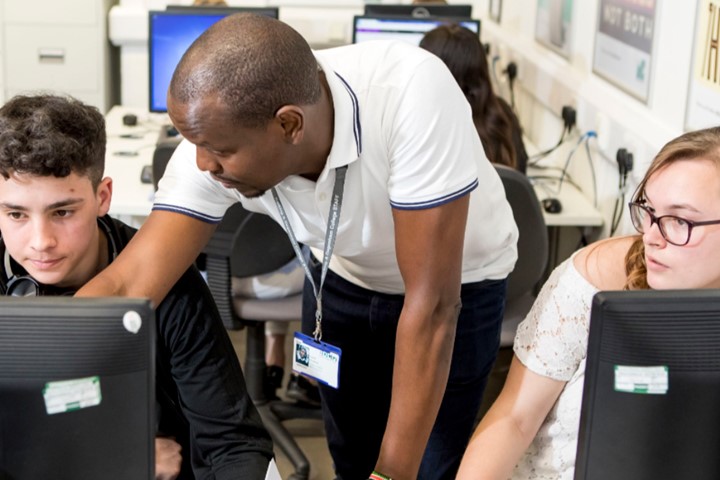Ideas to improve your remote teaching
Over the past year a wide range of teaching approaches have been developed, tested and refined while FE and training providers continue to offer remote education. Here we look at some tips to support you during the third lockdown and throughout 2021.
Replicating the classroom environment
The skills you have already developed as a teacher or trainer in a live classroom setting may not always be easy to replicate in a remote environment. However, by recreating some aspects of this interactivity, you will find that teaching is likely to be more effective in motivating and helping your learners progress.
The Education Endowment Foundation (EEF) has outlined a number of different facts which will determine the effectiveness of online teaching. These include:
- Ensuring learners receive clear explanations.
- Supporting growth in confidence with new material through scaffolded practice.
- Application of new knowledge or skills.
- Enabling learners to receive feedback on how to progress.
Teaching learners in the classroom as well as remotely
It may be that you are teaching learners in the classroom in addition to those who are isolating or working from home. There are ways you can help learners at home and in the classroom to benefit from sharing the experience equally. One idea could be to use a projector to share your screen with the students in the classroom – this will increase engagement and give the students more opportunity to have more of a collaborative learning experience.
Another suggestion is that in-class learners also join the lesson on their own devices, but mute their mics. The use of the chat option will mean there is interaction with the class as a whole – whether they are learning at home or in the classroom. Padlet, a virtual post board, is one way of providing a collaborative space for learners to work together whilst apart.
Guidelines to help deliver effective teaching remotely
- While using an interactive platform, such as Microsoft Teams or Google Classroom, you may want to consider having everyone muted to begin with to reduce disruptive background noise. You may also want to blur out your background, so no judgement is passed on your home environment.
- Time should be set aside for the usual catch ups that would otherwise happen in class. You may find it useful to prepare a list of topics to discuss which are not Covid-19-related, especially while lockdown is restricting much of the usual things you may have talked about previously.
- Show your face – research overwhelmingly suggests that online learners engage morewith a face than just with a presentation. That said, you can still screen share important information while learners are engaged in activities.
- Break the learning up into bite-sized manageable chunks – this will make your learners more likely to remain engaged. Depending on the age and level of your class (learners with SEND will often need more of a tailored approach), you may want to consider shorter lessons if learners are ‘switching off’ before the session ends.
- Pre-record parts of the lesson – not only will this take the pressure off you – it is also a great way for you to see the experience from the learners’ perspective.
- Record the whole session so that learners can access them later on or refer back to certain parts they need to watch again. This will also make flexible use possible if devices are limited or shared in households. If this is required, it is important that contact is maintained on a regular basis through questioning, feedback, or emails exchanging information about the work. If you have access to simple editing software, you could edit the day’s session into topics and upload it to the virtual learning environment (VLE) for bitesize revision – this may also end up being useful in the next year.
- Other resources, which include good quality free and subscription-based online resources, can be linked or embedded into your virtual classroom. One example is DfE-funded Isaac Physics.
- Keep learners engaged with short quizzes – you can also look for apps which have pre-written questions as well as the chance to write your own. Google forms, Kahoot, Classkick, Socrative and Edpuzzle are some examples of software which work well for rapid feedback – they also allow live marking.
- Make sure you that you try to ask everyone in the class a question during the lesson – it will keep them engaged and make them feel appreciated, but allow them to answer in the chat, as they may not feel comfortable replying verbally. You do not know how noisy it is where they are sitting, or who else they may disturb by speaking out.
- Be consistent with your lesson delivery. Research has shown that learners often like to stick to a similar format when learning online, so try to have a model structure to your lesson. Read more about this with Gilly Salmon's Five Stage Model.
- Provide an opportunity for learners to feed back to you about the lesson. You can do this in the form of a simple online form/survey (such as Menti). And remember, act on their feedback – they will appreciate it!
- Check out this list of virtual whiteboards for teachers. If you have a tablet, a virtual whiteboard application should allow you to interact within documents with your class too.
- If you are teaching from home, set up a suitable area to record yourself. You may also want to ask your organisation if they can get you a small tripod and a ring light to improve the quality of your recordings, but generally the most important thing is that the sound quality is good. So do find a time and space where you can ensure it will be quiet.
- Put the focus of your teaching on recapping knowledge that you have already taught – allowing deeper exploration of a topic will reinforce learners’ understanding. Additionally, you might think about the concept of the flipped classroom. This could mean you ask them to read up the factual content, or watch a video, before the lesson and then in the lesson you discuss and explain, rather than deliver the facts.
- Encourage the use of textbooks alongside any remote learning to provide a structure to the learning, keep learners on track and help them answer questions (ideally a textbook they can obtain online through the library if not a standard issued text).
- If you need support, don’t be afraid to reach out to colleagues or your mentor. Above all remember that everyone is finding this difficult, and so be kind to them, and most importantly to yourself.
You can also access advice and information in the following places:
- FE Advice: If there is anything you do not understand and want some more information and advice you can contact 0300 303 1877 or email feadviceline@etfoundation.co.uk.
- New FE Teacher Supportline: Teachers and trainers new to the FE sector can call the New FE Teacher Supportline on 0333 103 8401 or email newfeteacher@etfoundation.co.uk (open between 9am and 5pm Monday to Friday).
- Law Express: Free and confidential legal advice through Law Express as part of your SET membership
With thanks to the Education and Training Foundation’s (ETF) Head of Online Learning, Linsey Taylor, and Engage Education for contributing to the ideas in this article with blogs on Ideas for stress-free remote learning and Support for teachers new to remote teaching.




